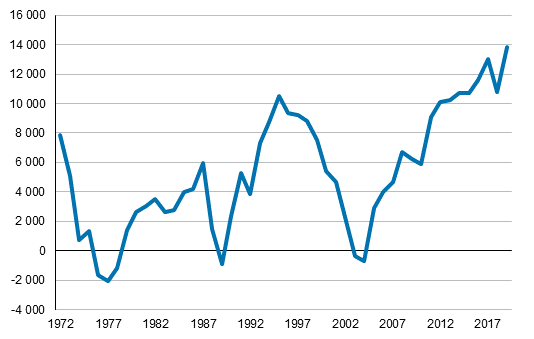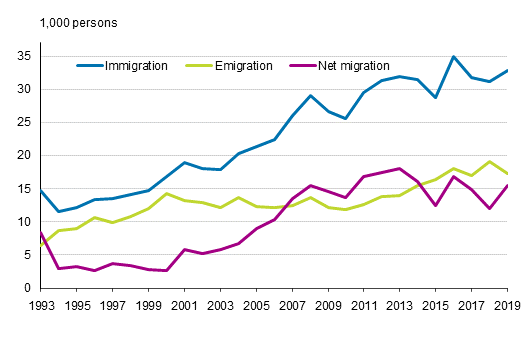Published: 14 May 2020
Total net migration in Greater Helsinki highest in at least 50 years
Corrected on 14 May 2020. The table was corrected. The correction is indicated in red.
According to Statistics Finland, the combined total net migration of municipalities in Greater Helsinki was 13,867 persons in 2019. The number is highest in at least 50 years. Total net migration includes migration gain from elsewhere in Finland and from abroad. Foreign-language speakers accounted for 71 per cent of total net migration in Greater Helsinki.
Total net migration in Greater Helsinki in 1972 to 2019

Finland received more migration gain from abroad than in the
previous year
Finland's migration gain from abroad grew in 2019 by around one third compared with the previous year. The migration gain rose to 15,495 from 11,965 persons in the year before. The reason for the higher migration gain was an increase in immigration and a decrease in emigration. In 2019, altogether 32,758 persons moved to Finland from abroad and 17,263 persons moved abroad from Finland.
Migration between Finland and other countries 1993–2019

The number of persons that moved to Finland from abroad grew by 1,652 persons. Of immigrants, 24,178 or 74 per cent were foreign citizens in 2019. Emigration from Finland decreased by 1,878 persons, or 10 per cent from the previous year. Fifty-eight per cent or 10,036 of emigrants were Finnish citizens. Finland's migration gain from foreign citizens amounted to 16,951 persons, but Finnish citizens generated a migration loss of 1,456 persons.
Immigration gain from immigrants from outside the EU
Finland's migration gain consisted almost completely of immigrants from outside the EU in 2019. Immigration from other than EU countries grew by good 2,000 from the previous year, while immigration from EU countries remained almost at the same level. Net immigration from countries outside the EU grew to 14,289 from the previous year's 12,733.
The immigration gain was largest in Russian citizens, 1,787 immigrants and second largest in Iraqi citizens, 1,182 immigrants. Third most immigration gain to Finland came from Indian citizens, 1,078 immigrants.
Migration gain in the region of Uusimaa highest in 20 years
In intermunicipal migration, the region of Uusimaa received
8,114 persons in migration gain from the rest of Finland. The
number is biggest since 1999. Foreign-language speakers in Finland
concentrate on Uusimaa, as nearly one-half of the migration gain
received by Uusimaa from the rest of Finland were foreign-language
speakers.
In addition to Uusimaa, only Pirkanmaa (1,872 persons) and
Southwest Finland (887 persons) received migration gain from
elsewhere in Finland.
Vantaa and Espoo received the largest migration gains
Vantaa (3,033 persons) and Espoo (2,535 persons) received the
largest migration gain from intermunicipal migration. Two-thirds of
the migration gain in Vantaa and one-half of the migration gain in
Espoo were foreign-language speakers.
Examined in relative terms, Sipoo, Kempele and Kauniainen received
most migration gain. Only around every sixth municipality received
migration gain from migration within Finland.
Migration loss of over one thousand persons in four regions
Of the regions, Kymenlaakso, South Savo, Satakunta and Ostrobothnia suffered migration loss of over one thousand persons to the rest of Finland. Examined in relative terms, migration loss was biggest in the regions of South Savo and Kymenlaakso.
Kouvola, Mikkeli and Kotka lost most
Migration losses from intermunicipal migration were biggest in Kouvola (639 persons) and Mikkeli (610 persons). The migration loss of Kotka was 546 persons.
Examined in relative terms, migration loss was biggest in the municipalities of Punkalaidun, Honkajoki and Uurainen.
Migration gain for regions from immigration
All regions received migration gain from international migration. Taking that into account, the number of regions with migration loss falls somewhat. The sum of net immigration and net internal migration was negative in eleven regions. In Mainland Finland, net regional immigration was highest in Ostrobothnia and lowest in Kanta-Häme in relative terms.
Internal migration and in- and out-migration 2005–2019 (The table was corrected on 14 May 2020.)
| Year | Intermunicipal | Intramunicipal | Immigration | Emigration | Net migration |
| 2005 | 267 892 | 624 077 | 21 355 | 12 369 | 8 986 |
| 2006 | 265 412 | 600 154 | 22 451 | 12 107 | 10 344 |
| 2007 | 272 245 | 596 025 | 26 029 | 12 443 | 13 586 |
| 2008 | 262 379 | 567 694 | 29 114 | 13 657 | 15 457 |
| 2009 | 257 544 | 577 719 | 26 699 | 12 151 | 14 548 |
| 2010 | 264 312 | 575 373 | 25 636 | 11 905 | 13 731 |
| 2011 | 274 825 | 600 852 | 29 481 | 12 660 | 16 821 |
| 2012 | 274 587 | 595 226 | 31 278 | 13 845 | 17 433 |
| 2013 | 265 792 | 578 012 | 31 941 | 13 893 | 18 048 |
| 2014 | 267 754 | 571 820 | 31 507 | 15 486 | 16 021 |
| 2015 | 280 210 | 613 535 | 28 746 | 16 305 | 12 441 |
| 2016 | 282 207 | 590 880 | 34 905 | 18 082 | 16 823 |
| 2017 | 287 775 | 592 115 | 31 797 | 16 973 | 14 824 |
| 2018 | 288 425 | 595 656 | 31 106 | 19 141 | 11 965 |
| 2019 | 286 700 | 596 171 | 32 758 | 17 263 | 15 495 |
Source: Migration 2019. Statistics Finland
Inquiries: Matti Saari 029 551 3401, Markus Rapo 029 551 3238, Juhana Nordberg 029 551 3051, info@stat.fi
Director in charge: Jari Tarkoma
Publication in pdf-format (287.8 kB)
- Tables
-
Tables in databases
Pick the data you need into tables, view the data as graphs, or download the data for your use.
- Figures
- Quality descriptions
-
- Quality description, migration 2019 (14.5.2020)
Updated 14.05.2020
Official Statistics of Finland (OSF):
Migration [e-publication].
ISSN=1797-6782. 2019. Helsinki: Statistics Finland [referred: 5.1.2026].
Access method: http://stat.fi/til/muutl/2019/muutl_2019_2020-05-14_tie_001_en.html

